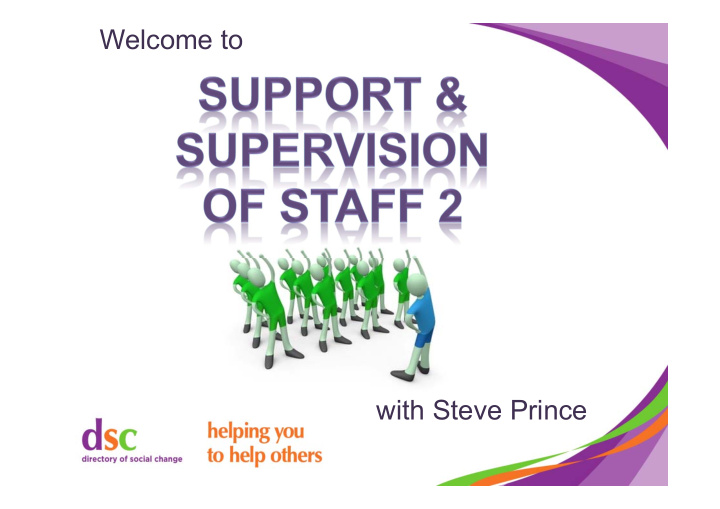



Goals
SMART Goals • Specific • Measurable • Achievable • Relevant • Time-bound
SMART Goals ‘To do a better job at paying supplier invoices.’ ‘To spend less next year on temporary staffing.’ ‘To provide better training opportunities for staff.’ ‘To reduce the average proposal preparation time by 15% by 31 December 2015.’
SMART Goals Do what? (action verb) ‘reduce’ To what? (effected subject) ‘average proposal time’ To what end? (desired result) ‘by 15%’ By when? (timetable) ‘by 31 December 2015’
Do NOT set annual goals Unless you’re forced to
Coffee
Monitoring Performance
Sources of Evidence Where can you get good information from on a persons performance?
Sources of Evidence • Observation • Individual (self appraisal) • Feedback from internal and/or external contacts • Internal audit reports • Physical evidence/output (reports, e-mails, complaints, praise from third parties etc.) • Records & management information (statistical analyses, financial budget/target achievement) • Training records
Never check anyone’s work on a continuous basis Unless legislation demands it
3 Crucial Management Actions 1. Walk the Job 2. Talk to the Team 3. Meet with Every Individual
One to Ones The key to high performance A regular and frequent conversation with someone about their self, their behaviour and their performance
Benefits of Regular 1:1s • Improves relationship • Gives sense of direction • Opportunity to set targets • Discuss ideas/suggestions • Review progress • Feedback for boss • Give recognition • Helps boss achieve goals • Raise queries/grievances • Cuts down interruptions
Your chance to: • Re-define their responsibilities • Find out how they think they are doing • Discuss problems in the job situation • Get their ideas for improving their job • Give praise for work well done • Give constructive criticism on areas of improvement
1:1 structure Introduction – set the scene Or - just ask two questions Achievements over period ? (praise) Challenges experienced/most stretching issues? 1. What have you done over this past month that you are proud of? What have they learned from above? 2. What have you done over this past month What do they see as priorities for coming month? that you could have done better? Progress on current targets? Summary & time of next meeting
Take every opportunity to hand the ‘process’ over to them Including appraisals
Handling Underperformance
Praise Specific Proportional Unconditional Sincere Timely Earned
What is Under-performance? Unacceptable performance against job requirements
Under-Performance is: • Not performing job tasks fully or adequately • Not meeting reasonable targets or standards of performance • Not meeting the skill, competency or knowledge requirements of the job • Inappropriate behaviour (e.g. poor time-keeping; bad behaviour towards others etc.)
Resolving Under-Performance Nature of under- Remedy performance “One-off” minor issue Brief early challenge Slight adjustment needed Brief early challenge Full solution Developed over time Deep-rooted or significant Full solution shortfall
The brief early challenge Step 1 • Describe Step 2 • Explain DELIA Step 3 • Listen Step 4 • Identify Alternative(s) Step 5 • Agree Action
Either way, you must let them know that ‘no action’ is NOT an option
Lunch + Yes I’m afraid it is another … Questionnaire
Resolving Conflict
Recent Conflict Briefly write about a recent personal conflict
How does conflict make you feel? How would you prefer to feel, ideally?
About Conflict… • It is not necessarily bad • It is likely to occur when people or groups share different beliefs, interests, or goals • It can be uncomfortable and stressful but not addressing it can drive it underground • The goal of conflict resolution isn’t to eliminate it but to learn how to handle it constructively
If handled well conflict can… • Increase the awareness of problems • Promote change • Enhance morale and cohesion • Lead to high quality decisions • Stimulate interest and creativity • Legitimise people’s interests • Strengthen relationships
Questionnaire
Highest 8-12 9-12 9-12 8-12 6-12 25% Middle 4-7 6-8 5-8 5-7 3-5 50% Lowest 0-3 0-5 0-4 0-4 0-2 25%
Conflict Handling Modes Focusing on own needs and outcomes Competing Collaborating A I win, you lose I win, you win s s e r I win, t Compromising i you win a bit more v e n e Accommodating s Avoiding I lose, you win s I lose, you lose Co-operativeness Co-operativeness Focusing on others needs and mutual relationships
Your preferences 1. What might be the uses of your more dominant modes? 2. In what situations might you struggle if you do not learn to use your less dominant modes?
Which mode is best? • All are useful in some situations and represent a set of useful social skills • Effectiveness depends on the of the specific situation and the skill with which it is used • You are capable of using all five modes • You will use some modes more than others
Resolving Conflict • Keep the conversation focused on the issue – We communicate more than words and ideas, we communicate attitudes. • Have a mutual purpose – Working toward a common outcome shows we care about the other person’s goals, interest and values. • Show mutual respect – When people perceive that others don’t respect them, the conversation immediately becomes unsafe and dialogue becomes defensive.
Tea
Recommend
More recommend